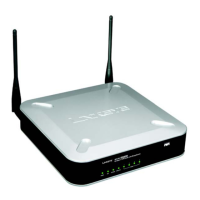24
Chapter 6: Configuring the Wireless-G VPN Router
The Setup Tab - Advanced Routing
Wireless-G VPN Router with RangeBooster
building a route to an entire network, be sure that the network portion of the IP address is set to 0. For
example, the Router’s standard IP address is 192.168.1.1. Based on this address, the address of the routed
network is 192.168.1, with the last digit determining the Router’s place on the network. Therefore you would
enter the IP address 192.168.1.0 if you wanted to route to the Router’s entire network, rather than just to the
Router.
Subnet Mask. The Subnet Mask (also known as the Network Mask) determines which portion of an IP
address is the network portion, and which portion is the host portion. Take, for example, a network in which
the Subnet Mask is 255.255.255.0. This determines (by using the values 255) that the first three numbers of a
network IP address identify this particular network, while the last digit (from 1 to 254) identifies the specific
host.
Gateway. Enter the IP address of the gateway device that allows for contact between the Router and the
remote network or host.
Interface. Select LAN & Wireless or Internet, depending on the location of the static route’s final
destination.
Show Routing Table. Click the Show Routing Table button to open a screen displaying how packets are routed
through your local network. For each route, the Destination LAN IP address, Subnet Mask, Gateway, and Interface
are displayed. Click the Refresh button to update the information. Click the Close button to exit this screen.
When you have finished making changes to the screen, click the Save Settings button to save the changes, or
click the Cancel Changes button to undo your changes. For help information, click More.
Figure 6-13: Routing Table Entry List

